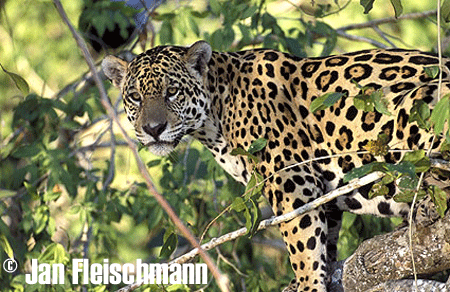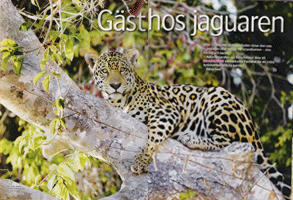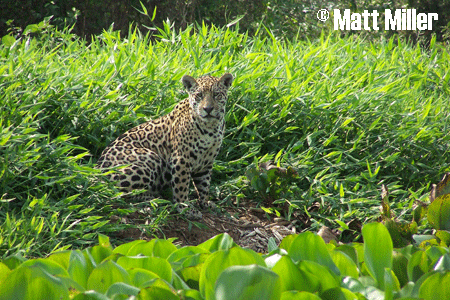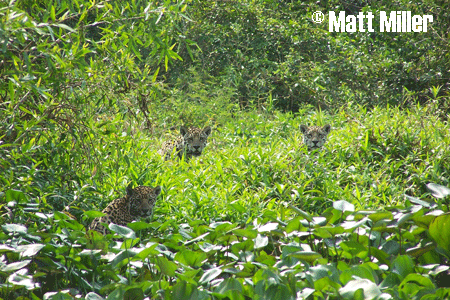
HONESTY, PROFESSIONALISM AND FRIENDSHIP MAKE THE DIFFERENCE.
Read some trip reports:
Jaguar Tracking Tours:
Testimonials

Video Testimonials
Mitsuaki Iwago (Japan)
Chalie Lynam (UK)
Richard & Joy Evans (USA)
Joshua (USA) and Amanda (UK)

Jaguar | Pantanal Trackers Tours

Jaguar | Pantanal Trackers Tours

Jaguar | Pantanal Trackers Tours

Jaguar | Pantanal Trackers Tours
Jaguar tour
Jan Fleischmann (Sweden)
Jan Fleischmann is a professional wildlife photograher. In 2005 he joined Julinho on a jaguar tour in the Northern Pantanal (Porto Jofre area). Some of best pictures he took during his jaguar tour are published in the Pantanal Trackers Gallery in the top menu on this website. They are also published in the jaguar photo album on this website.
Article
The following article about his jaguar tour with Pantanal Trackers was published in a Swedish magazine:


Jaguar | Pantanal Trackers Tours

Jaguar | Pantanal Trackers Tours

Jaguar | Pantanal Trackers Tours

Jaguar | Pantanal Trackers Tours
Jaguar tour
Matt Miller (USA)
In 2007 Matt Miller and his wife Jennifer went on a jaguar tour with Julinho. He wrote the following trip report which is also published on his blog of Idaho Nature Notes.
Far Afield: Brazil's Pantanal, Land of the Jaguar
I wanted to see a capybara.
That was my main hope on a recent trip to the Pantanal. I've always had a strange fascination with capybaras--something about a rodent the size of a Labrador retriever that roams in herds had captured my imagination since I was a kid. On two previous trips to South America in areas reputed to be capybara habitat, I had never seen one of the world's largest rodent.
Julinho Monteiro, our local guide for the trip, responded to my request, "You usually can't guarantee wildlife sightings, but I'll guarantee you'll see lots of capybaras. Lots of caimans, and lots capybaras."
My wife Jennifer and I were in Brazil's Pantanal, the world's largest wetland located in western Brazil. The Nature Conservancy recognizes it for its incredible wildlife diversity, and is working on unique collaborative partnerships to protect it. This huge area--which includes parts of Brazil, Paraguay and Bolivia--is not a national park, but is rather covered in cattle ranches. Each year, rivers flowing through this grassland flood their banks, and then recede, concentrating birds, reptiles and mammals around the ponds that remain.
I knew it was biologically important, but that fact doesn't really capture the spirit and beauty of the Pantanal. Within minutes of entering onto the Transpanteneira, a dirt roadway that dead ends in the middle of the Pantanal, we were seeing birds of every size, color and description. And caimans. Thousands of caimans.
What about the capybaras?
Oh yes. Herds--yes, herds--were constantly appearing around each bend of the river. All the capybaras I could want to see, observe and photograph, and then some more.
Although most South American natural areas are not known for their mammal viewing opportunities, here we saw a tremendous number and variety of strange and wonderful creatures--giant anteater, tapir, howler and capuchin monkey, peccary, swamp deer, armadillo, giant otter, crab-eating fox.
And then: Deep into the Pantanal, camping on the front yard of a family that lived 8 hours by boat and car from the nearest town. In this area, we were looking for that most elusive of Pantanal animals: the jaguar.
The first appears like a ghost sitting in grass along the riverbank. The jaguar appears indifferent about the encounter. I am not. This is stepping into the dream world of my youth: the world brought to me by Ranger Rick and Marlin Perkins and mountains of library books filled with travel and adventure.
But this jaguar is just the beginning. Within an hour, we see three more. Julinho Monteiro, an independent guide who started his own company, Pantanal Trackers, has an almost supernatural ability to find the spotted cats.
The next day, we see another: a mature female that falls asleep with us watching. We take photos and watch it, and then it's time to drift away, on to see what else the Pantanal has in store.
Matt Miller





Jaguar tour
Mike Lane (UK)
Full time wildlife photographer Mike Lane is specialising in birds and mammals. Take a look at his website.
August 2007
Our guide had seen this all many times before, but was clearly delighted. His face filled with a wide grin. He had achieved his objective and was a happy man, although it had taken longer than expected. This was our third day, but on the river bank only 20 metres away was a male jaguar staring curiously at the human visitors to his domain, totally unfazed.
Julinho had his first big cat experience as a 5 year old accompanying his grandfather on a jaguar hunt armed with spears. By the age of just 15 he was a guide and today provides photographers with their best chance of photographing jaguars in the wild.
Not many years ago nearly every decent jaguar photograph was taken in captivity. Zoos in Belize and Ecuador providing the best setting and access. In recent years however tourists have been returning from boat trips in the Amazon and Pantanal wetlands with perfectly acceptable images of wild cats.
In the Brazilian Pantanal especially jaguars are thriving. Although protected for many years in a wetland area as large as the U.K. and mostly inaccessible there was no way to enforce the law and ranchers regularly killed jaguars. It was hard enough to make a living from cattle without losing a few to this largest race of this elusive cat.
However in recent times cattle rearing has become unsustainable in the area and many ranches have either closed or turned to ecotourism and now see the jaguar as an asset to their land. As a result the Pantanal is teaming with this large cat and attracting a growing number of tourists to see them. In turn the cat is becoming ever more tolerant of the tourist boats and seeing wild jaguar today is probably no more difficult (or easy) than seeing wild tigers in India. Both require an element of luck.
We had been close to this cat for 30 minutes now our cameras whirling away as the cat just purred back. Julinho had told us what would happen when we first saw a cat.
He would not stop, but continue to motor past as if we had not seen it. This would give the cat confidence that we had not seen it. 50 metres later he would turn the boat around and sail back pulling up upstream of the jaguar on the opposite bank.
From here we would drift with the current past our target. He would then repeat the exercise using the motor to go back upstream and drift back quietly a bit closer each time, making a judgement from the cats behaviour on how approachable it would be.
Within 10 minutes we were as close as we wanted to be.
Over the remaining 3 days of our trip we saw several sightings of Jaguar. On two occasions I was amazed that Julinho was able to get us up close enough to photograph on foot after mooring the boat on the bank.
Although Julinho can cope with larger numbers two is probably the ideal number. Any more and he would have to rent a larger boat.
Mike Lane



Jaguar tour
Sisser Dynesen (Denmark)
Before I went to the Pantanal I had no idea that jaguars have no 'routine' or 'favorite spots' which they keep returning to each day.
On our last day on the river I had therefore actually given up hoping we would see a jaguar and had focused on enjoying the monkeys, the jaguar footprints, the caimans, the birds, the silence and the special treat of visiting a local family on the river bank in the middle of absolutely nowhere in Pantanal.
But then suddenly it was there - right in front of us! Swimming across the river towards the bank. It is one of those moments you just don't forget!
We came quite close but the jaguar didn't seem to worry - it just continued its path, got up on the river bank and dissappeared into the woods.
Afterwards you sit back with a feeling of utterly joy - that you have managed to see the great cat but more importantly - that you have seen it in its own environment and have had the pleasure while avoiding to interfere significantly in its life.
The jaguar was definately the highlight of the trip into Pantanal but even if we had not seen a cat I would still have had the trip among the highlights on my tour around Brazil.
I think it was a combination of an amazing environment and Julinho's ability to put together a custom made trip based on our priorities - both in terms of activities and comfort requirements.
Our trip was a 5 day tour where the first day was spent on the dirt road (and bridges) to Ponto Jofre. We then spend two days in a small boat travelling up the river and into smaller water streams looking for birds and mammals and jaguars in particular. We camped by the river bank and had a great opportunity to meet Maria and her kind family including dogs, pigs and chickens. I was sad that I had not taken a language course but with sign language and Julinho as translator communication went quite well anyway.
The following two days we stayed at a fazenda in the Northern part of the Pantanal where we saw a zillion special birds and a number of Brazilian mammals. During the day time we went horseback riding, walked and went on some river trips. One of the evenings Julinho and some of his friends ended up creating a small band with guitars, bells, candy boxes and a mixed crowd of more and less trained vocals. I think they had great fun - and so did we.
I can highly recommend Julinho as a tour guide - the man have eyes like a hawk, speaks English very well, knows a lot about the animals and the environment, pays attention to your priorities and last but not least - he is not too bad to hang out with for a week or so :-)
Sisser Dynesen
Pantanal tour
Tad & Rita Foringer (USA)
In mid-August 2005 we visited the Pantanal in Brazil, which is the world’s largest freshwater wetland or alluvial plain. We flew to Cuiaba where we met our guide, Julinho Monteiro, speaks eight languages, sings and plays guitar very well, and has his private pilot license. He learned all about medicinal plants from his grandfather and has vast knowledge about wildlife and the Pantanal. A great guide!!
We traveled in Julinho’s SUV south from Cuiabá and entered the Transpantaneira Road near Poconé. This is a 145km raised gravel road with many bridges, some quite rickety, that runs south to Porto Jofre, which is near the center of the Pantanal Matogrossense National Park. We stayed at four different lodges. We traveled by SUV, motorboat, canoe and horseback and did a lot of hiking.
The driest season is July to September and the wildlife congregates around watering holes making it very easy to see the abundant wildlife. During the wettest season, much of the Pantanal is flooded. So what did we see? Many mammals, including tapir, capybara, agouti, coati, crab-eating fox, marsh and tropical deer, monkeys (capuchin, brown howler, black howler), giant and tropical otter.
We saw caiman by the hundreds and were surprised at their large size (up to seven feet) and density around the watering places. We did a lot of spotlighting at night and to see a hundred red eyes around a small pond is memorable! We also saw a nice 3-foot long iguana.
The Pantanal is a birdwatcher’s paradise. We saw the rhea, southern screamer, great horned owl, great potoo, crimson headed and white headed woodpecker, hyacinth macaw, canary wing and black hooded parrot, blue front amazon, monk and peach fronted parakeet and too many small birds and flycatchers to list. Among the raptors were the laughing falcon, and many hawks (grey, black, savannah, roadside, and black collared). The water birds were amazing with snowy and cattle egret, whistling duck, spoonbill, jabiru and wood storks, amazon and ring neck kingfisher, and heron (tiger, chicano, great blue, night and agami. The agami sighting is especially noteworthy because it is rare to see this timid and solitary bird.
The high light of the trip for Rita was a horseback ride with Julinho. It became exciting when he said that we were going to separate the horses from the cattle. Which is exactly what we did. Since I had not been horseback riding in many, many years, this was truly an adventure - one that I will not forget anytime soon.
Tad and Rita Foringer, Hampton Virgimia USA



